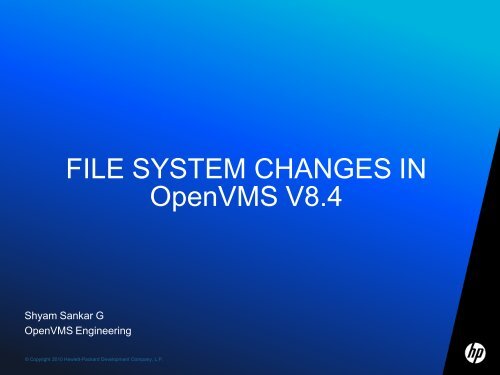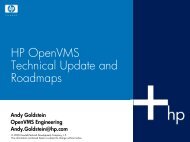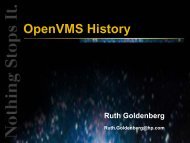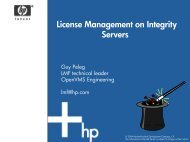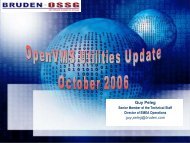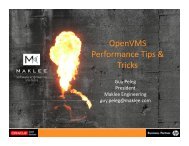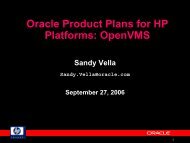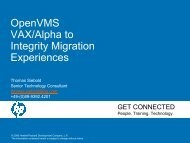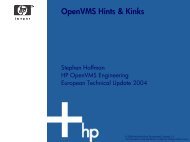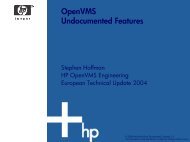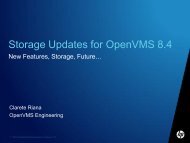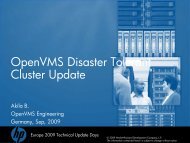FILE SYSTEM CHANGES IN OpenVMS V8.4
FILE SYSTEM CHANGES IN OpenVMS V8.4
FILE SYSTEM CHANGES IN OpenVMS V8.4
- No tags were found...
Create successful ePaper yourself
Turn your PDF publications into a flip-book with our unique Google optimized e-Paper software.
<strong>FILE</strong> <strong>SYSTEM</strong> <strong>CHANGES</strong> <strong>IN</strong><strong>OpenVMS</strong> <strong>V8.4</strong>Shyam Sankar G<strong>OpenVMS</strong> Engineering1© Copyright © Copyright 2010 Hewlett-Packard 2010 Development Development Company, Company, L.P. L.P.
Disabling XFC caching– $ MOUNT /NOCACHE DKA0: MYVOL– Read I/O performed from disk, when caching is disabledA.txt B.txt C.txt D.txtApplicationDKA0: (MYVOL)A.txt B.txt C.txt D.txt5© Copyright 2010 Hewlett-Packard Development Company, L.P.
<strong>V8.4</strong> Solution: Use new [NO]DATA keyword– Enhanced $ MOUNT qualifier /CACHE• Differentiates XFC and XQP cache– New with <strong>V8.4</strong>:• /CACHE=NODATA: MOUNT volume, but no data cache• /CACHE=DATA: MOUNT volume, enable data cache (same as /CACHE)– Does not change the settings of the metadata caches• EXTENT, <strong>FILE</strong>_ID, QUOTA• These are also controlled with the /CACHE qualifier7© Copyright 2010 Hewlett-Packard Development Company, L.P.
Special Consideration for Mixed VersionCluster– $ MOUNT /CACHE=NODATA /CLUSTER– Pre-<strong>V8.4</strong> nodes cannot perform such a mount– Will return %MOUNT-W-RMTMNTFAIL• <strong>V8.4</strong> nodes will mount successfully– $ MOUNT /CACHE /CLUSTER works as always8© Copyright 2010 Hewlett-Packard Development Company, L.P.
V8.3 Limitations and <strong>V8.4</strong> Solutions–Limitation:–Caching enabled/disabled only with $ MOUNT• To change caching attribute, must dismount /cluster and mount again–Solution:–Use new $ SET VOLUME /CACHE qualifier to changecaching on the fly9© Copyright 2010 Hewlett-Packard Development Company, L.P.
<strong>V8.4</strong> Solution: Modify caching statusdynamically– New qualifier "/CACHE" with “$ SET VOLUME”• /CACHE=NODATA: Disable further caching of volume• /CACHE=DATA: Enable caching of volume– No need to dismount the volume10© Copyright 2010 Hewlett-Packard Development Company, L.P.
V8.3 limitations and <strong>V8.4</strong> Solutions– All volumes compete for entire cache memory• Good and bad• Buffers provided on demand, but lower-priority volume can dominateXFC cache memoryCached BuffersLeft: Blue volumeoccupies all cacheRight: Orangevolume displacesblue buffersXFC cache memoryCached Buffers11© Copyright 2010 Hewlett-Packard Development Company, L.P.
<strong>V8.4</strong> Solution: Modify caching statusdynamically– New qualifier "/CACHE" with “$ SET VOLUME”– … and the CLEAR_DATA keyword• /CACHE=CLEAR_DATA: Free up cached buffers of volume– Example: Disable XFC cache and free up buffers• $ SET VOLUME ORANGE_VOL /CACHE=(NODATA,CLEAR_DATA)– Example: Re-enable XFC cache• $ SET VOLUME ORANGE_VOL /CACHE=DATA12© Copyright 2010 Hewlett-Packard Development Company, L.P.
<strong>V8.4</strong>: Now we can…–Free-up „orange‟ buffers from cache–Stop „orange‟ buffers from beingcachedXFC cache memoryCached BuffersApp–Allow more „blue‟ buffers to becachedXFC cache memoryCached BuffersApp13© Copyright 2010 Hewlett-Packard Development Company, L.P.
Summary: Advantages to <strong>V8.4</strong> Changes– No downtime to change volume caching• Can change volume caching on demand– Can prevent cache from filling up with useless data• Good for performance– Can enable/disable caching on system disk– Can disable data caching without affecting metadataperformance14© Copyright 2010 Hewlett-Packard Development Company, L.P.
2 TB support15© Copyright 2010 Hewlett-Packard Development Company, L.P.
Existing Limitation– V8.3 file system supports volumes up to 1TB• Single disk volume is 1TB or less• Bound volume set can have 255 such volumes– Logical Block Number (LBN) is signed 32-bit integer3127001 1 11 1 1 … … … 1– 1TB limitation comes from the following calculation:• LBN 0 through 0x7FFFFFFF -> 0x80000000 blocks * 0d512 bytes = 1 TB16© Copyright 2010 Hewlett-Packard Development Company, L.P.
<strong>V8.4</strong>: 2TB volumes– Device drivers and I/O subsystem: 64-bit LBN• SCSI disks only– These support 2 TB• RMS, XQP, <strong>IN</strong>IT, MOUNT, BACKUP, SHADOW<strong>IN</strong>G, MSCP• Use sign bit to double capacity– These continue with current limits• DFO: No change, still 1 TB• C RTL: No change• NFS: No change– Retrieval Pointer format: NO CHANGE• 30-bit Count stays, each „extent‟ 512 GB17© Copyright 2010 Hewlett-Packard Development Company, L.P.
<strong>V8.4</strong>: 2TB volumes$ show dev/full $1$DGA100:Disk $1$DGA100: (COEREF), device type COMPAQ MSA1000 VOLUME, is online,allocated, deallocate on dismount, mounted, file-oriented device, shareable,served to cluster via MSCP Server, error logging is enabled.Error count 0 Operations completed 1657976Owner process "_TNA2:" Owner UIC [<strong>SYSTEM</strong>]Owner process ID 21400434 Dev Prot S:RWPL,O:RWPL,G:R,WReference count 4 Default buffer size 512Current preferred CPU Id 0 Fastpath 1WWID 01000010:6001-4380-0008-E010-3250-94C7-EF07-000CTotal blocks 3145728000 Sectors per track 255Total cylinders 48378 Tracks per cylinder 255Logical Volume Size 3145728000 Expansion Size Limit 4261348350Allocation class 1::18© Copyright 2010 Hewlett-Packard Development Company, L.P.
2 TB on older VMS version– Older VMS versions (pre <strong>V8.4</strong>)– $ MOUNT will incorrectly mount 2 TB volume• Unpredictable results!– $ MOUNT made to fail in patch, as a safety measure• %MOUNT-F-UNSUPPORTED, unsupported operation or function– Unpatched MOUNT does not have safety measure!– Install latest patches• V73-2R: VMS732_MOUNT96-V0200• V82R: VMS82A_MOUNT96-V0100• VMS821I_MOUNT96-V0100• V83R: VMS83A_MOUNT96-V0100• VMS83I_MOUNT96-V0100• V83-1H1R: Not Released Yet19© Copyright 2010 Hewlett-Packard Development Company, L.P.
Impact, Challenges– DCL symbols are signed 32-bit• Lexicals can return unsigned 32-bit• F$GETDVI VOLSIZE, FREEBLOCKS, etc• Techniques/workarounds to handle unsigned symbols• See <strong>V8.4</strong> DCL Dictionary, Appendix– Applications handling LBNs: Change signed to unsigned• Source code changes• Arithmetic operations on LBN must be converted to 64-bit operations• Comparisons must be unsigned20© Copyright 2010 Hewlett-Packard Development Company, L.P.
SYML<strong>IN</strong>KENHANCEMENTS21© Copyright 2010 Hewlett-Packard Development Company, L.P.
Outline– What is a symlink– Symlinks on <strong>OpenVMS</strong>– V8.3 Limitations and <strong>V8.4</strong> Solutions• Programming Interface• Metadata– Compatibility Between V8.3 and <strong>V8.4</strong>22© Copyright 2010 Hewlett-Packard Development Company, L.P.
About symlinks– Symbolic link, symlink, soft link– Pointer to a target object– Target object: file name, directory name, arbitrary string– On <strong>OpenVMS</strong>, a symlink is implemented as a separate file• The file contains the target string– On UNIX, a symlink is not a file at all, but only a directory entry• The entry contains the symlink name and target string– Supported by most Unix-like operating systems, Windows, … and ofcourse, <strong>OpenVMS</strong>23© Copyright 2010 Hewlett-Packard Development Company, L.P.
Advantages of Symlinks‣Unix-like development / runtime environment‣Eases porting of Unix applications to VMS24© Copyright 2010 Hewlett-Packard Development Company, L.P.
Symlinks on <strong>OpenVMS</strong>– Available starting with <strong>OpenVMS</strong> V8.3– Symlink is a special file– Target string stored as data in this file– File System interprets target string as POSIX path name– $ CREATE DKA1:[DIR1]SRC.LNK /SYML<strong>IN</strong>K=“/usr/target.c”Symlink FileTarget FileDKA1:[DIR1]SRC.LNK/usr/target.cDKA2:[USR]TARGET.C#include 25© Copyright 2010 Hewlett-Packard Development Company, L.P.
The /[no]symlink qualifier•Use it to distinguish between the symlink file and thetarget file.− Defaults to /symlink on DIRECTORY command− Defaults to /nosymlink on other commands26© Copyright 2010 Hewlett-Packard Development Company, L.P.
Symlinks on <strong>OpenVMS</strong>27© Copyright 2010 Hewlett-Packard Development Company, L.P.
POSIX pathnames on <strong>OpenVMS</strong>– Simulate Unix-like directory tree on VMS– $ SET ROOT• An <strong>OpenVMS</strong> directory acts as the UNIX “/”• Pathnames parsed relative to this root directory$ SET ROOT DKA100:[000000]$ SHOW ROOTDKA100:[000000]$ DIR “^UP^/dir1/dir2/a.txt”$! The above becomes $ DKA100:[DIR1.DIR2]A.TXT28© Copyright 2010 Hewlett-Packard Development Company, L.P.
Symlink file attributes$ dir /full src.lnk ! /symlink qualifier is assumed by defaultDirectory MDB0:[000000.DIR1]SRC.LNK;1 File ID: (14,1,0)Size: 1/1 Owner: [<strong>SYSTEM</strong>]Created: 22-AUG-2010 07:51:29.56Revised: 22-AUG-2010 07:51:29.56 (1)Expires: Backup: Effective: Recording: Accessed: Attributes: Modified: Linkcount: 1File organization: Special: symbolic linkLink Contents: /dir1/dir2/a.txtShelved state: OnlineCaching attribute: Writethrough::29© Copyright 2010 Hewlett-Packard Development Company, L.P.
Symlink file header$ dump /symlink /header /block=c=0 src.lnk ! /symlink to be stated explicitlyFile ID (14,1,0) End of file block 1 / Allocated 1File HeaderHeader areaIdentification area offset: 40Map area offset: 100Access control area offset: 255Reserved area offset: 255Extension segment number: 0Structure level and version: 5, 1File identification: (14,1,0)Extension file identification: (0,0,0)VAX-11 RMS attributesRecord type:noneFile organization:SpecialRecord attributes:Symbolic linkRecord size: 32767Highest block: 1End of file block: 1End of file byte: 2130© Copyright 2010 Hewlett-Packard Development Company, L.P.
V8.3 symlink limitations•Implementation not consistent− RMS/QIO programmer: Confusing attribute/field names• RMS uses „special‟, XQP uses „symlink‟− CRTL supports logical names but RMS does not− XQP provides some flags, RMS doesn‟t use them•To know if dir entry = symlink− XQP provides DIR$V_TYPE, but not used− Need to read File Header (need read access to file)•RMS performance problems, minor functional deficiencies•All of these limitations addressed in <strong>V8.4</strong>31© Copyright 2010 Hewlett-Packard Development Company, L.P.
Symlinks: what‟s new in <strong>V8.4</strong>– Interface and metadata changes– RMS enhancements• Fuller support for POSIX pathnames• Fuller support for Logical Names in POSIX paths• Search List support• Wildcards– Symlink compatibility between V8.3 and <strong>V8.4</strong>• Converting VMS 8.3 Symlinks to VMS 8.4 Symlinks32© Copyright 2010 Hewlett-Packard Development Company, L.P.
Programming interface changes– No changes needed in your program, if using:• DCL commands• Lexicals• C RTL• RMS– Changes are in ACP QIO interface• You are impacted if you use ACP QIO and deal with symlinks• RMS and CRTL interface to XQP suitably updated33© Copyright 2010 Hewlett-Packard Development Company, L.P.
ACP QIO changes– New flags defined to request/identify symlink– Naming convention consistency – „special‟ instead of „symlink‟– Need to re-compile ACP QIO program!On V8.3! <strong>IN</strong>PUT: Operate on symlink, not targetMY_FIB [FIB$V_SYML<strong>IN</strong>K] = 1;! Make QIO callstatus = SYS$QIOW (..., IO$_ACCESS, ...,FIB_DESC, file_desc, ...);! OUTPUT: Did XQP operate on symlink?IF (.MY_FIB [FIB$V_SYML<strong>IN</strong>KENTRY]) THEN::On <strong>V8.4</strong>! <strong>IN</strong>PUT: Operate on symlink, not targetMY_FIB [FIB$V_CHECK_SPECIAL] = 1;! Make QIO callstatus = SYS$QIOW (..., IO$_ACCESS, ...,FIB_DESC, file_desc, ...);! OUTPUT: Did XQP operate on symlink?IF (.MY_FIB [FIB$V_IS_SPECIAL]) THEN::34© Copyright 2010 Hewlett-Packard Development Company, L.P.
V8.3 Metadata limitation•No symlink indicator in directory entry− Was defined but not actually used− Indicator was only in File Header•Caused a File Header read− Two issues:• Extra overhead• False Audit Alarm•Corrected with new DIR$V_SPECIAL flag in directoryentry35© Copyright 2010 Hewlett-Packard Development Company, L.P.
Metadata: Directory Entry Flags– Directory entry -> Flags Byte -> New flag bit to indicate symlink• DIR$V_SPECIAL in DIR$B_FLAGS• Same as DIR$V_NEXTREC– XQP enforces relation to File Header symlink attributes• Creating symlink sets entry flag AND header attributes$ dump/dir v83_dir.dir0000 Directory Entry:0000 Size: 200002 Version limit: 327670004 Type: 0 (FID)0004 Name type: 0 (ODS-2)0005 Name count: 70006 Name: SRC.LNK000E Version: 1 FID: (14,1,0)0016 End of records (-1)$ dump/dir v84_dir.dir0000 Directory Entry:0000 Size: 200002 Version limit: 327670004 Type: 0 (FID)DIR$V_NEXTREC bit set0004 Name type: 0 (ODS-2)0005 Name count: 70006 Name: SRC.LNK000E Version: 1 FID: (14,1,0)0016 End of records (-1)36© Copyright 2010 Hewlett-Packard Development Company, L.P.
V8.3 False AUDIT ALARM– Only File Header can tell if file is symlink or not– For a dir lookup (RMS $SEARCH), XQP has to read File Header– Read-Attributes triggers access failure audit if enabled%%%%%%%%%%% OPCOM 2-NOV-2007 09:00:39.97 %%%%%%%%%%%…Auditable event:Object accessEvent information: read file attributes request (IO$_ACCESS or IO$_CREATE)…Process owner: [100,101]Terminal name:TNA4:Object class name: <strong>FILE</strong>Object owner: [100,100]Object protection: <strong>SYSTEM</strong>:RWE, OWNER:RWE, GROUP:E, WORLD:EFile name:_$80$DKB0:[TEST]TEST.TMP;1File ID: (42504,40,0)Access requested:READ…Status:%<strong>SYSTEM</strong>-F-NOPRIV, insufficient privilege or objectprotection violation37© Copyright 2010 Hewlett-Packard Development Company, L.P.
Metadata: Volume Characteristics– Home block -> Volume characteristics field -> New flag bit• HM2$V_NO_SPECIAL_<strong>FILE</strong>S in HM2$W_VOLCHAR– $ SET VOLUME, new parameter NOSPECIAL_<strong>FILE</strong>S– Eliminates False Audit Alarm$ show dev /full mda0::Volume Status: ODS-5, subject to mount verification, file high-water marking,XFC caching is disabled, write-back XQP caching enabled, special filesenabled.$ set volume mda0 /volume_characteristics = NOSPECIAL_<strong>FILE</strong>S$ show dev /full mda0::Volume Status: ODS-5, subject to mount verification, file high-water marking,XFC caching is disabled, write-back XQP caching enabled.$38© Copyright 2010 Hewlett-Packard Development Company, L.P.
COMPATIBILITY: V8.3, <strong>V8.4</strong> SYML<strong>IN</strong>KSAnysymlinksV8.2 system(older VMS)“invalid file organization” error<strong>V8.4</strong>symlinksV8.3 systemCompatible. Commands work.V8.3symlinks<strong>V8.4</strong> systemMost commands work. Not alwaysguaranteed. Recommend converting.39© Copyright 2010 Hewlett-Packard Development Company, L.P.
ANALYZE /DISK /REPAIR– $ analyze/disk checks consistency of symlink attributes/flags• Checks if dir entry flag DIR$V_SPECIAL corresponds to File Header file orgFAT$C_SPECIAL• Checks version limit = 1 for symlink file– /REPAIR „upgrades‟ V8.3 symlink entry to <strong>V8.4</strong> entry• This is recommended.$analyze/disk/repair $10$DKB200:…%ANALDISK-W-BADSYMENTRY, directory entry for SYM_ON_83. in directory(61531,39558,0) example.link does not match symlink attribute in fileheader…40© Copyright 2010 Hewlett-Packard Development Company, L.P.
RMS: SYML<strong>IN</strong>KS AS LOGICAL NAMES- Translates the first element of an absolute pathname- Equivalence string in the path is substituted in the path if thetranslation succeeds.- Logical Name can be a search list.41© Copyright 2010 Hewlett-Packard Development Company, L.P.
RMS: SYML<strong>IN</strong>KS <strong>IN</strong> SEARCH LISTS$ define example SYS$SYSDEVICE:[example1.],SYS$SYSDEVICE:[example2.]$ create/symlink="/example" search_link$ dir [.search_link]Directory SYS$SYSDEVICE:[000000.SEARCH_L<strong>IN</strong>K]EXAM1_<strong>FILE</strong>1.DAT;1 EXAM1_<strong>FILE</strong>2.DAT;1 EXAM1_<strong>FILE</strong>3.DAT;1 EXAM2_<strong>FILE</strong>1.DAT;1EXAM2_<strong>FILE</strong>2.DAT;1Total of 5 files.$ ! Note we see files from both directories in the search list42© Copyright 2010 Hewlett-Packard Development Company, L.P.
RMS: SYML<strong>IN</strong>KS WILDCARD CONTROL– In a $SEARCH operation, whether symlinks are to be followed or notdepends on how the namespace is structured and the intent of theuser.– A user can control this using set process/symlink commandSET PROCESS/SYML<strong>IN</strong>K=keywordNOWILDCARDWILDCARDNOELLIPSISELLIPSISdo not follow symlinks in directory wildcardingfollow symlinks in all wildcarded directoryspecifiersfollow symlinks matched by any wildcard fields inthe directory string except ellipsisequivalent to WILDCARD (included for commandsymmetry)43© Copyright 2010 Hewlett-Packard Development Company, L.P.
Symlinks Summary: What You Need to Do–Make coding change if using the ACP $QIOinterface.–Recommend converting existing symlinks to <strong>V8.4</strong>using ANALYZE DISK /REPAIR.–Use new RMS features44© Copyright 2010 Hewlett-Packard Development Company, L.P.


